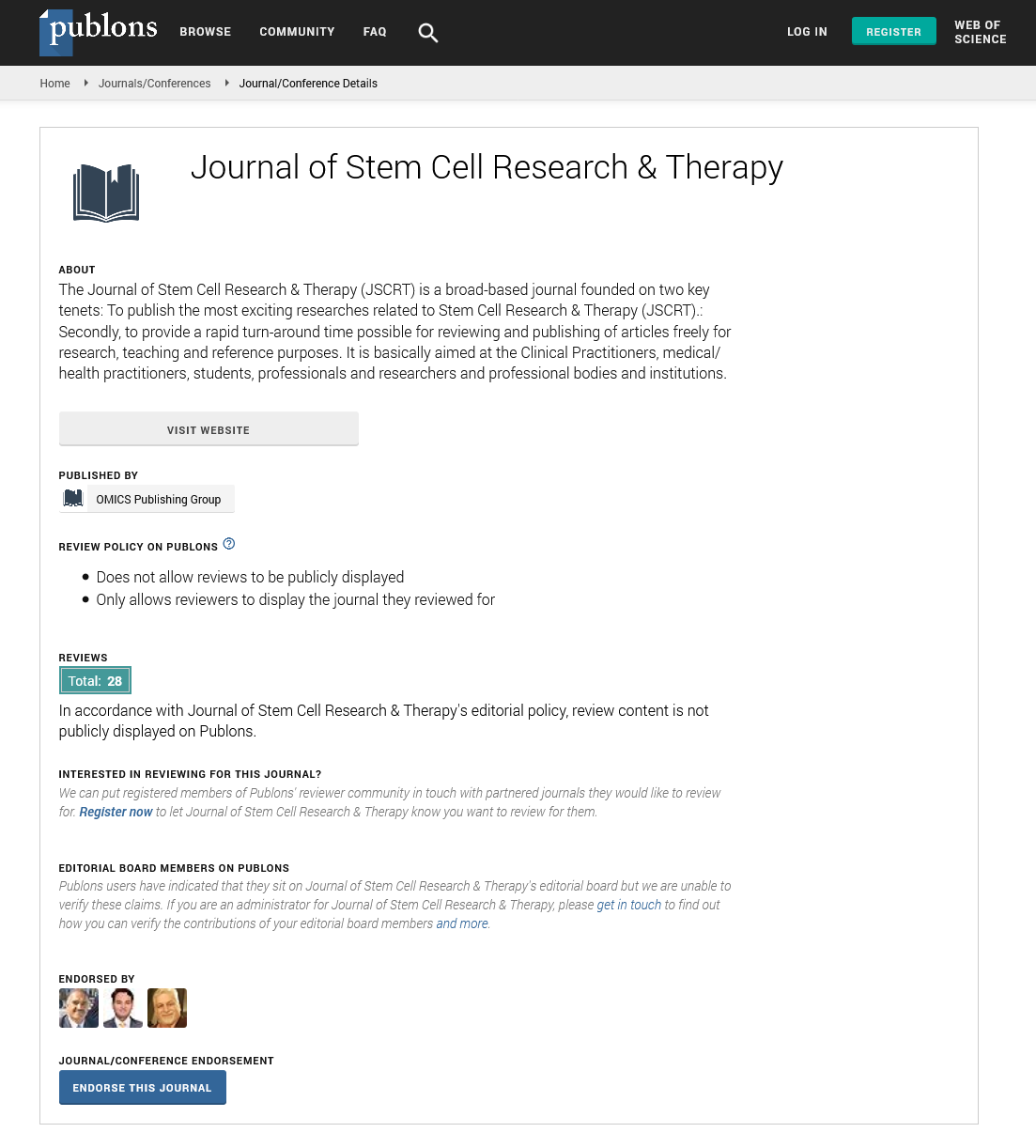Indexed In
- Open J Gate
- Genamics JournalSeek
- Academic Keys
- JournalTOCs
- China National Knowledge Infrastructure (CNKI)
- Ulrich's Periodicals Directory
- RefSeek
- Hamdard University
- EBSCO A-Z
- Directory of Abstract Indexing for Journals
- OCLC- WorldCat
- Publons
- Geneva Foundation for Medical Education and Research
- Euro Pub
- Google Scholar
Useful Links
Share This Page
Journal Flyer

Open Access Journals
- Agri and Aquaculture
- Biochemistry
- Bioinformatics & Systems Biology
- Business & Management
- Chemistry
- Clinical Sciences
- Engineering
- Food & Nutrition
- General Science
- Genetics & Molecular Biology
- Immunology & Microbiology
- Medical Sciences
- Neuroscience & Psychology
- Nursing & Health Care
- Pharmaceutical Sciences
Opinion Article - (2022) Volume 12, Issue 6
Epigenetics in Stem Cell Proliferation and Differentiation
Received: 01-Jun-2022, Manuscript No. JSCRT-22-17280; Editor assigned: 06-Jun-2022, Pre QC No. JSCRT-22-17280(PQ); Reviewed: 20-Jun-2022, QC No. JSCRT-22-17280; Revised: 28-Jun-2022, Manuscript No. JSCRT-22-17280(R); Published: 05-Jul-2022, DOI: 10.35248/2157-7633.22.12.541
Description
All cells in an organism are the derivative of pre-existing cells, beginning with the fertilized egg, which results blastocyst, which, in turn, gives rise to the cells of the whole organism. These stem cells have the sole property of being totipotent, meaning they can give rise to any type of cell in the organism, including a placenta. The two major properties of stem cells are proliferation and differentiation. Stem cells can proliferate and differentiate into suitable lineages to form particular cells. The potential for each type of stem cell to become specialized depends on its plasticity, or the degree to which it is, or can become, totipotent, pluripotent or multipotent. Owing to their plasticity, stem cells are very valuable in the field of regenerative medicine, especially as a potential cell replacement therapy for many diseases. For example, the bone marrow-derived mesenchymal stem cells have the ability to secrete Brain Derived Neurotrophic Factor (BDNF), Vascular Endothelial Growth Factor (VEGF), Nerve Growth Factor (NGF) and Insulin like Growth Factor 1 (IGF-1) as a treatment for neurodegenerative disorders and spinal cord injury. Within the context of treatments for neurodegenerative disorders, stem cells have enormous therapeutic potential, particularly: (1) Mesenchymal Stem Cells (MSCs), which can be derived from Bone Marrow (BM-MSCs); (2) Neural Stem Cells (NSCs), derived from Embryonic Mouse brain tissues (eNSCs); and (3) Induced Pluripotent Stem Cells (iPSCs). In specific, the iPSCs can be resulting from fibroblasts and then driven into a neuronal lineage, distinguishing into what seems to be mature neurons, which may be able to replace lost nerve cells. An added benefit of using exogenous stem cells for treatment strategies is that they can be genetically adapted to overexpress certain proteins that become down regulated in some brain diseases.
As discussed above, the MSCs can be inherently modified to overexpress Brain Derived Neurotrophic Factor (BDNF), which is one of the main trophic factors that is downregulated in Huntington’s Disease (HD), a neurodegenerative disorder characterized by loss of average spiny neurons in the striatum.
Likewise, MSCs can be reformed to express Glial Derived Neurotrophic Factor (GDNF) to promote dopaminergic neuronal sprouting to cure Parkinson’s Disease (PD). In addition, these MSCs can also be used to overexpress Nerve Growth Factor (NGF) to ease memory deficits in Alzheimer’s Disease (AD). Though, one of the drawbacks of stem cell transplantation is the immune response that rises during allogenic transplantation. However, at least one study has established that adult stem cells, when used in their undifferentiated form, can escape immune elimination and do not pose any adverse effects.
However, the exact mechanism whereby stem cells usually multiply and separate into specific lineages, or even what determines the fate of these stem cells, is not yet understood. Gaining new insights into these endogenous procedures may assist researchers with how exogenous stem cells may be more capably manipulated in ways that would optimize their therapeutic efficacy for treating neurodegenerative diseases.
Manipulation of stem cells includes epigenetic regulation, which can be used to move these stem cells towards the lineage of interest, making them for subsequent use as a cell replacement therapy. Numerous recent studies have specified that epigenetic processes play a vital role in normal gene expression and cell differentiation. The knowledge of role of these epigenetic processes should help successful stem cell reprogramming in the creation of iPSCs, which need several genetic factors.
Conclusion
In culture, some of the stem cells undergo epigenetic changes, while others remain unaffected during passaging or reprogramming. Understanding why certain cells utilize epigenetic processes during differentiation, both in vitro and in vivo, may help us invent new ways in which the epigenetic process can be used to enhance or control propagation and differentiation of stem cells.
Citation: Walters E (2022) Epigenetics in Stem Cell Proliferation and Differentiation. J Stem Cell Res Ther. 12:541.
Copyright: © 2022 Walters E. This is an open-access article distributed under the terms of the Creative Commons Attribution License, which permits unrestricted use, distribution, and reproduction in any medium, provided the original author and source are credited.

